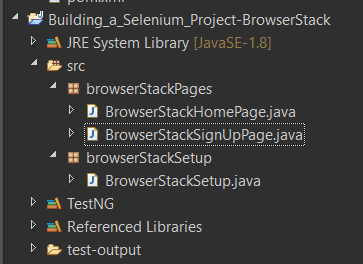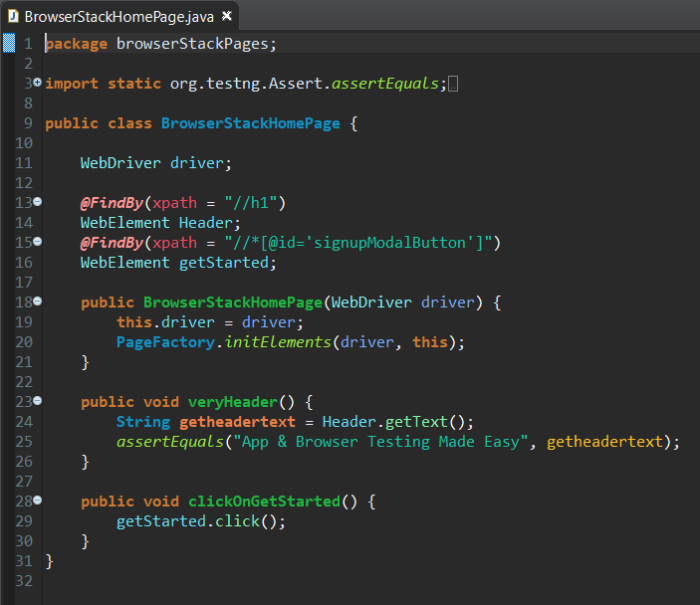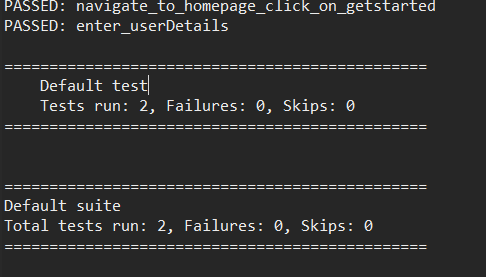Page Object Model and Page Factory in Selenium
By Chaitanya Pujari, Community Contributor - November 27, 2024
Page Object Model and Page Factory are tools in Selenium that are popularly used in test automation. This tutorial will demonstrate how to use Page Object Model and Page Factory in Selenium automation projects to maintain test cases easily.
- What is Page Object Model in Selenium?
- Advantages of Page Object Model
- Implementing POM in Selenium Project
- Sample Project Structure for POM
What is Page Object Model in Selenium?
Page Object Model, also known as POM, is a design pattern in Selenium that creates an object repository for storing all web elements. It helps reduce code duplication and improves test case maintenance.
In Page Object Model, consider each web page of an application as a class file. Each class file will contain only corresponding web page elements. Using these elements, testers can perform operations on the website under test.
Read More: Design Patterns in Automation Framework
Advantages of Page Object Model
- Easy Maintenance: POM is useful when there is a change in a UI element or a change in action. An example would be: a drop-down menu is changed to a radio button. In this case, POM helps to identify the page or screen to be modified. As every screen will have different Java files, this identification is necessary to make changes in the right files. This makes test cases easy to maintain and reduces errors.
- Code Reusability: As already discussed, all screens are independent. By using POM, one can use the test code for one screen, and reuse it in another test case. There is no need to rewrite code, thus saving time and effort.
- Readability and Reliability of Scripts: When all screens have independent java files, one can quickly identify actions performed on a particular screen by navigating through the java file. If a change must be made to a specific code section, it can be efficiently done without affecting other files.
Implementing POM in Selenium Project
As already discussed, each java class will contain a corresponding page file. This tutorial will create 2-page files.
- BrowserStackHomePage
- BrowserStackSignUpPage
Each of these files will contain UI elements or Objects which are present on these screens. It will also contain the operations to be performed on these elements.
Also Read: How to Build and Execute Selenium Projects
Sample Project Structure for POM
BrowserStackHomePage Java File
Explanation of Code
- Code Line-10 to 11: Identifying elements present on BrowserStack Home Page such as header and Get Started button
- Code Line-17 to 24: Performing actions on identified objects on BrowserStack Home Page
Code Snippet
package browserStackPages;
import static org.testng.Assert.assertEquals;
import org.openqa.selenium.By;
import org.openqa.selenium.WebDriver;
public class BrowserStackHomePage {
WebDriver driver;
By Header=By.xpath("//h1");
By getStarted=By.xpath("//*[@id='signupModalButton']");
public BrowserStackHomePage(WebDriver driver) {
this.driver=driver;
}
public void veryHeader() {
String getheadertext=driver.findElement(Header).getText();
assertEquals("App & Browser Testing Made Easy", getheadertext);
}
public void clickOnGetStarted() {
driver.findElement(getStarted).click();
}
}BrowserStackSignUpPage Java File
Explanation of Code
- Code Line-10 to 14: Identifying elements present on BrowserStack SignUp Page such as header and Get Started button
- Code Line-20 to 35: Performing actions on identified objects on the BrowserStack SignUp Page
Code Snippet
package browserStackPages;
import static org.testng.Assert.assertEquals;
import org.openqa.selenium.By;
import org.openqa.selenium.WebDriver;
public class BrowserStackSignUpPage {
WebDriver driver;
By Header = By.xpath("//h1");
By userName = By.xpath("//*[@id='user_full_name']");
By businessEmail = By.xpath("//*[@id='user_email_login']");
By password = By.xpath("//*[@id='user_password']");
public BrowserStackSignUpPage(WebDriver driver) {
this.driver = driver;
}
public void veryHeader() {
String getheadertext = driver.findElement(Header).getText().trim();
assertEquals("Create a FREE Account", getheadertext);
}
public void enterFullName(String arg1) {
driver.findElement(userName).sendKeys(arg1);
}
public void enterBusinessEmail(String arg1) {
driver.findElement(businessEmail).sendKeys(arg1);
}
public void enterPasswrod(String arg1) {
driver.findElement(password).sendKeys(arg1);
}
}BrowserStackSetup Java File
Explanation of Code
- Code Line-21 to 27: Setting up browser and website to execute test scripts
- Code Line-29 to 43: Initializing driver object to BrowserStackHomePage & BrowserStackSignUpPage and performing actions on those pages
Code Snippet
package browserStackSetup;
import java.util.concurrent.TimeUnit;
import org.openqa.selenium.WebDriver;
import org.openqa.selenium.chrome.ChromeDriver;
import org.testng.annotations.BeforeTest;
import org.testng.annotations.Test;
import browserStackPages.BrowserStackHomePage;
import browserStackPages.BrowserStackSignUpPage;
public class BrowserStackSetup {
String driverPath = "C:\\geckodriver.exe";
WebDriver driver;
BrowserStackHomePage objBrowserStackHomePage;
BrowserStackSignUpPage objBrowserStackSignUpPage;
@BeforeTest
public void setup() {
System.setProperty("webdriver.chrome.driver", "C:\\BrowserStack\\chromedriver.exe");
driver = new ChromeDriver();
driver.manage().timeouts().implicitlyWait(10, TimeUnit.SECONDS);
driver.get("https://www.browserstack.com/");
}
@Test(priority = 1)
public void navigate_to_homepage_click_on_getstarted() {
objBrowserStackHomePage = new BrowserStackHomePage(driver);
objBrowserStackHomePage.veryHeader();
objBrowserStackHomePage.clickOnGetStarted();
}
@Test(priority = 2)
public void enter_userDetails() {
objBrowserStackSignUpPage = new BrowserStackSignUpPage(driver);
objBrowserStackSignUpPage.veryHeader();
objBrowserStackSignUpPage.enterFullName("TestUser");
objBrowserStackSignUpPage.enterBusinessEmail("TestUser@gmail.com");
objBrowserStackSignUpPage.enterPasswrod("TestUserPassword");
}
}What is Page Factory in Selenium?
Page Factory is a class provided by Selenium WebDriver to support Page Object Design patterns. In Page Factory, testers use @FindBy annotation. The initElements method is used to initialize web elements.
- @FindBy: An annotation used in Page Factory to locate and declare web elements using different locators. Below is an example of declaring an element using @FindBy
@FindBy(id="elementId") WebElement element;
Similarly, one can use @FindBy with different location strategies to find web elements and perform actions on them. Below are locators that can be used:
- initElements(): initElements is a static method in Page Factory class. Using the initElements method, one can initialize all the web elements located by @FindBy annotation.
- lazy initialization: AjaxElementLocatorFactory is a lazy load concept in Page Factory. This only identifies web elements when used in any operation or activity. The timeout of a web element can be assigned to the object class with the help of the AjaxElementLocatorFactory.
Implementing Page Factory in Selenium Project
This will try to use the same project used for the POM Model. It will reuse the 2-page files and implement Page Factory.
- BrowserStackHomePage
- BrowserStackSignUpPage
As discussed earlier, each of these files will only contain UI elements or Objects present on these screens along with the operations to be performed on these elements.
Sample Project Structure for Page Factory
The project structure will not change as the same project is being used. As already mentioned, Page Factory supports Page Object Model design pattern.
BrowserStackHomePage Java File
Explanation of Code
- Code Line-13 to 17: Identifying elements present on BrowserStack Home Page such as header and Get Started button using Page Factory @FindBy annotation
- Code Line-23 to 30: Performing actions on identified objects on the BrowserStack Home Page
Code Snippet
package browserStackPages;
import static org.testng.Assert.assertEquals;
import org.openqa.selenium.WebDriver;
import org.openqa.selenium.WebElement;
import org.openqa.selenium.support.FindBy;
import org.openqa.selenium.support.PageFactory;
public class BrowserStackHomePage {
WebDriver driver;
@FindBy(xpath = "//h1")
WebElement Header;
@FindBy(xpath = "//*[@id='signupModalButton']")
WebElement getStarted;
public BrowserStackHomePage(WebDriver driver) {
this.driver = driver;
PageFactory.initElements(driver, this);
}
public void veryHeader() {
String getheadertext = Header.getText();
assertEquals("App & Browser Testing Made Easy", getheadertext);
}
public void clickOnGetStarted() {
getStarted.click();
}
}BrowserStackSignUpPage Java File
Explanation of Code
- Code Line-14 to 24: Identifying elements on BrowserStack SignUp Page, such as the header and Get Started button, using Page Factory @FindBy annotation.
- Code Line-26 to 46: Performing actions on identified objects on the BrowserStack SignUp Page
Code Snippet
package browserStackPages;
import static org.testng.Assert.assertEquals;
import org.openqa.selenium.WebDriver;
import org.openqa.selenium.WebElement;
import org.openqa.selenium.support.FindBy;
import org.openqa.selenium.support.PageFactory;
public class BrowserStackSignUpPage {
WebDriver driver;
@FindBy(xpath = "//h1")
WebElement Header;
@FindBy(xpath = "//*[@id='user_full_name']")
WebElement userName;
@FindBy(xpath = "//*[@id='user_email_login']")
WebElement businessEmail;
@FindBy(xpath = "//*[@id='user_password']")
WebElement password;
public BrowserStackSignUpPage(WebDriver driver) {
this.driver = driver;
PageFactory.initElements(driver, this);
}
public void veryHeader() {
String getheadertext = Header.getText().trim();
assertEquals("Create a FREE Account", getheadertext);
}
public void enterFullName(String arg1) {
userName.sendKeys(arg1);
}
public void enterBusinessEmail(String arg1) {
businessEmail.sendKeys(arg1);
}
public void enterPasswrod(String arg1) {
password.sendKeys(arg1);
}
}BrowserStackSetup Java File
Explanation of Code
- Code Line-21 to 27: Setting up of browser and website to execute our scripts
- Code Line-29 to 43: Initializing driver objects to BrowserStackHomePage & BrowserStackSignUpPage and performing actions on those pages.
Code Snippet
package browserStackSetup;
import java.util.concurrent.TimeUnit;
import org.openqa.selenium.WebDriver;
import org.openqa.selenium.chrome.ChromeDriver;
import org.testng.annotations.BeforeTest;
import org.testng.annotations.Test;
import browserStackPages.BrowserStackHomePage;
import browserStackPages.BrowserStackSignUpPage;
public class BrowserStackSetup {
String driverPath = "C:\\geckodriver.exe";
WebDriver driver;
BrowserStackHomePage objBrowserStackHomePage;
BrowserStackSignUpPage objBrowserStackSignUpPage;
@BeforeTest
public void setup() {
System.setProperty("webdriver.chrome.driver", "C:\\BrowserStack\\chromedriver.exe");
driver = new ChromeDriver();
driver.manage().timeouts().implicitlyWait(10, TimeUnit.SECONDS);
driver.get("https://www.browserstack.com/");
}
@Test(priority = 1)
public void navigate_to_homepage_click_on_getstarted() {
objBrowserStackHomePage = new BrowserStackHomePage(driver);
objBrowserStackHomePage.veryHeader();
objBrowserStackHomePage.clickOnGetStarted();
}
@Test(priority = 2)
public void enter_userDetails() {
objBrowserStackSignUpPage = new BrowserStackSignUpPage(driver);
objBrowserStackSignUpPage.veryHeader();
objBrowserStackSignUpPage.enterFullName("TestUser");
objBrowserStackSignUpPage.enterBusinessEmail("TestUser@gmail.com");
objBrowserStackSignUpPage.enterPasswrod("TestUserPassword");
}
}Test Result
Try Selenium Testing on a Real Device Cloud
Useful Resources:
- Page Object Model and Page Factory in Selenium
- What is Cypress Page Object Model?
- Page Object Model with Playwright: Tutorial
- Page Object Model in Selenium and JavaScript
- Page Object Model and Page Factory in Selenium C#
- Page Object Model and Page Factory in Selenium Python
Difference between Page Object Model & Page Factory in Selenium
| Page Object Model | Page Factory |
|---|---|
| Finding web elements using By | Finding web elements using @FindBy |
| POM does not provide lazy initialization | Page Factory does provide lazy initialization |
| Page Object Model is a design pattern | PageFactory is a class that implements the Page Object Model design pattern. |
| In POM, one needs to initialize every page object individually | In PageFactory, all page objects are initialized by using the initElements() method |
Run the code to test the workings of the Page Object Model (POM) and Page Factory. Since these are important Selenium functions, testers need to be able to use them with ease and accuracy for Selenium automation. This will help them streamline automation testing efforts and get results quicker.
Other Design Patterns used in Selenium
Other Design Patterns used in Selenium
Design Patterns in Test Automation Framework are pivotal. There are different other design patterns that are used in Selenium such as:
- Singleton Design Pattern
- Fluent Page Object Model
- Factory Design Pattern
- Facade Design Pattern
Singleton Design Pattern: The Singleton design pattern ensures that no more than one instance of a class is created. It is often used when a single instance of an object is required to coordinate actions across the system. For example, in Selenium, the WebDriver object is typically a Singleton, as there should be only one instance of the browser for the entire test run.
Fluent Page Object Model: The Fluent Page Object Model is an extension of the Page Object Model, where methods are chained together to form a fluent interface. This makes the test code more readable and concise, as multiple actions can be performed on the page in a single line of code.
Factory Design Pattern: This is used to create instances of classes. It is often used when a single class is not enough to create the required objects, and multiple subclasses are required. This pattern provides a way to encapsulate the object creation process and makes it easier to change the object creation process without affecting the rest of the code.
Facade Design Pattern: The Facade design pattern provides a simplified interface to a complex system. It is used to make it easier to use the system by hiding its complexity behind a single interface. The Facade pattern can be used in Selenium to provide a simplified API for interacting with the browser, making it easier to write tests that are maintainable and easy to read.
Read More: Design Patterns in Selenium











